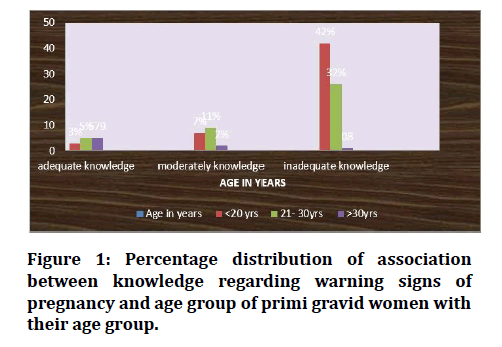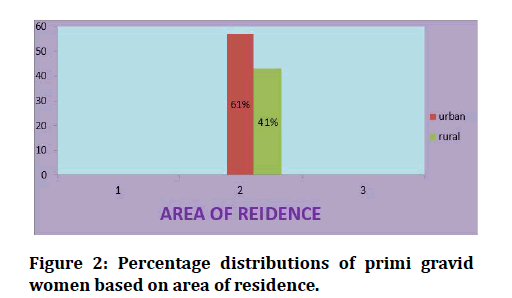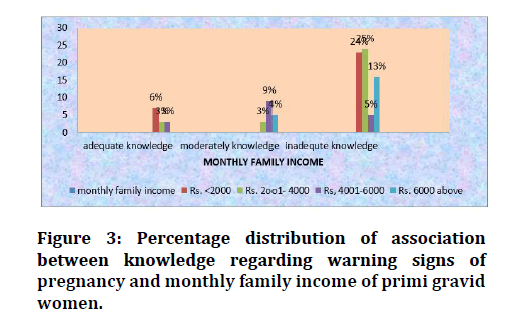Research - (2021) Volume 9, Issue 8
Impacts of Prenatal Teaching on Mothersâ Breastfeeding Self-Efficacy: Reliability and Validity Assessment
*Correspondence: AR Bharathi, Department of Nursing, Bharath Institute of Higher Education and Research, India, Email:
Abstract
This study investigates the efficacy of video assisted teaching programme on warning signs of pregnancy surrounded by primi gravid women attending outpatient department at primary health Guduvancherry. To assess the knowledge on warning signs of pregnancy among primi gravid women during pretest. To evaluate the effectiveness of video assisted teaching programme by Comparing Pre & Post test score. Research design used for the study was a pre-experimental design. This study was conducted in primary health Guduvancherry. The population for the present study consisted of 60 antenatal women. Simple random sampling technique was used to select the sample. This understood that the proper video assisted teaching programme on warning signs of pregnancy surely improve the knowledge on warning signs of pregnancy which will prevent the early complications among primi gravid women.
Keywords
Pregnancy, Demography, Age, Education, Occupation
Introduction
The video assisted teaching programme includes introduction, meaning, causes, list of warning signs, signs and symptoms, prevention and management, complication. Data collection tool consisted of demographic variables; questions regarding warning signs of pregnancy were used to assess the knowledge level [1,2]. The collected data were tabulated, analyzed and interpreted by using descriptive and inferential statistics. Establishment of content validity of data collection tool and video assisted teaching programme was done by experts [3].
Pilot study was conducted in Maduramangalm Primary Health Centre among antenatal women to find out the feasibility of conducting the study. The study finding shows that 42(70%) of the antenatal women had inadequate knowledge during their pre-test and 48(80%) acquired adequate knowledge during their post-test. Regarding the effectiveness of video assisted teaching programme on warning sign of pregnancy among primi gravid women, the result shows that the video assisted teaching programme was highly effective among primi gravid women between pre-test and post test score. The obtained value was significant at p 0.05 level [4,5].
Regarding the association between the knowledge on warning signs of pregnancy among primi gravid women with their selected demographic variables, the result revealed that there was a significant association with age, education, occupation, and monthly family income [6-9]. Above findings suggested that the video assisted teaching programme will help to improve the knowledge of the primi gravid women regarding warning signs of pregnancy. Based on these findings, the recommendations were drawn for nursing service, nursing administration, nursing education and nursing research [10-13].
Materials and Methods
The research methodology includes the strategies to be used, in collecting and analyzing data to accomplish the research objectives and to test research hypothesis. It has crucial implications for the validity and credibility of the study findings. This chapter gives a brief description of the methodology for the study to evaluate the effectiveness of video assisted teaching programme on knowledge related to warning signs of pregnancy among primi gravid women attending Outpatient Department at primary health Guduvancherry.
The content of the chapter includes the description of the research approach, research design, variables, setting of the study, population, sample, criteria for sample selection, sampling technique, development and description of instruments, method of data collection, development of teaching plan, pilot study, data collection procedure and plan for data analysis.
The research approach used for the study is Quantitative Research to assess the effectiveness of video assisted teaching programme on Warning signs of Pregnancy. A research design is a blueprint for the conduct of a study that maximizes control over factors that could interfere with the study’s desired outcome. In one group pre-testpost- test design, the dependent variable is measured, before the independent variable is applied. After an appropriate period, the dependent variable is measured again. In the analysis of the data the difference between the initial and terminal measures represents the effect of the independent variables (Table 1).
| Group | Pre test | Intervention |
Post test |
|---|---|---|---|
| O1 | X |
O2 |
|
| Antenatal women who are attending the antenatal Outpatient Department of primary health Guduvancherry | Assessing the knowledge level on warning signs of pregnancy during pretest. | Video assisted teaching programme on warning signs of pregnancy. |
Assessing the knowledge level on warning signs of pregnancy during posttest. |
Table 1: Research design.
Results
Results are mentioned in the Figures 1 to Figure 3.
Figure 1: Percentage distribution of association between knowledge regarding warning signs of pregnancy and age group of primi gravid women with their age group.
Figure 2: Percentage distributions of primi gravid women based on area of residence.
Figure 3: Percentage distribution of association between knowledge regarding warning signs of pregnancy and monthly family income of primi gravid women.
Discussion
This chapter presents the major findings of the study and discusses them in relation to the similar studies conducted by other researchers. The main aim of the present study was to evaluate the effectiveness of video assisted teaching programme on warning signs of pregnancy among primi gravid women attending outpatient primary health Guduvancherry.
One group pre-test post-test design was adopted for the study [14]. The population of the study was primi gravid women attending the antenatal clinics of primary health Guduvancherry and the sample size was 60. The structured interview questionnaire were used to assess the level of knowledge on warning signs of pregnancy among primi gravid women [15].
The data was analysed through both descriptive statistics (Mean, Frequency, Percentage and Standard deviation) and inferential statistics (paired ‘t’test and chi-square). Discussion on the findings were arranged based on the objectives of the study [15]. The first objective of the present study was to assess the level of knowledge on warning signs of pregnancy in primi gravid women during Pretest.
The present study findings revealed that, out of 60 samples most of them 42(70%) had inadequate knowledge,10(17%) had moderately adequate knowledge,8(13%) had adequate knowledge in the pretest and in post-test most of them 48(80%) had adequate knowledge,12(20%) had moderately adequate knowledge and none of them had inadequate knowledge. The findings were supported by A Descriptive study was conducted to assess the knowledge of Primi-Gravida mothers regarding breast feeding technique.
Data were collected from 100 Primi-Gravida women attending Antenatal OPD in primary health Guduvancherry by using self-structured interview schedule. The study revealed that most of the Primi- Gravida mothers 5% had average knowledge, 20 % had good knowledge and 75%had very good knowledge regarding the breast-feeding technique among primi gravid women [16,17].
The second objective was to evaluate the effectiveness of video assisted teaching programme by comparing pre and post test scores. The study revealed that the mean pre-test score was 8.17 and post-test knowledge score was 25.6, it was higher than the pre-test. The standard deviation of pre-test knowledge score 1.586 and post-test knowledge score 2.330. The obtained ‘t’ value was 43.803.It was significant at p<0.05% level. Hence the stated hypothesis was accepted [18].
These finding are consistent with the study done by Joshi et al. who conducted a study “to assess the level of knowledge, attitude, and practice of women on management of minor ailments”. It revealed that the knowledge, attitude, and practice had increased after structured teaching programme [13]. The third objective was to find out the association between the knowledge on warning signs of pregnancy in primi gravid women with the selected demographic variables. The study revealed that there was a significant association between the demographic variables like age, education, occupation, family income [19]. Hence the stated hypothesis was accepted for age, education, occupation, family income. These finding are consistent with the study to assess the knowledge of Primi-Gravida mothers regarding diet during pregnancy. Data were collected from 100 Primi-Gravida women attending Antenatal OPD in primary health Guduvancherry, by using selfstructured interview schedule. The chi-square value is significant when compared to the table value at 0.05 level of significance and it reveals that there is significant association between the knowledge scores of the mothers with age, education, type of the family, area of the residence and family income among Primi-Gravida mothers.
Conclusion
This chapter deals with summary, conclusion, and recommendations of the study. Further, it includes implications for nursing practice, nursing education, nursing administration and nursing research. The main aim of the present study confirms the effectiveness of video assisted teaching programme on warning signs of pregnancy among primi gravid women. This understood that the proper video assisted teaching programme on warning signs of pregnancy surely improve the knowledge on warning signs of pregnancy which will prevent the early complications among primi gravid women.
Funding
No funding sources.
Ethical Approval
The study was approved by the Institutional Ethics Committee.
Competing Interests
The authors declare no conflict of interest.
Acknowledgements
The encouragement and support from Bharath University, Chennai, is gratefully acknowledged. For provided the laboratory facilities to carry out the research work.
References
- Subaratnam A, Sivanesaratnam V, Pratap K. Essentials of obstetrics.1st Edn. New Delhi: Jaypee Medical Publishers 2004.
- Mudaliar AL, Mudaliar MK. Menon’s clinical obstetrics.10th Edn. New Delhi: Orient Longman Private Ltd 2003.
- Burroughs Arlene. Maternity nursing an introductory text.7th Edn. Philadelphia:W.B Saunders Company 1997.
- Sisir CK, Narayanaswami M. Text book of midwifery. New Delhi:BI publications Pvt Ltd 2001.
- Sheila B. Text book of obstetrics.1st Edn. Hyderabad:Paras Medical Publishers 2007.
- Helen V. Nurse-midwifery. 11th Edn. London: Jons and Barlett publishers 1987.
- Adele P. Maternal and child health nursing. 1st Edn. Missouri:Mosby publication 2003.
- Dawn CS Text book of obstetrics and neonatology. 12th Edn. Delhi:Dawn publication 1993.
- Gleora Barbara Kozier. Fundamentals of nursing. 7th Edn. New Delhi:Pearson Education 2004.
- Potter, Perry. Fundamentals of nursing. 6th Edn. Philadelphia:Mosby publications 2005.
- Basavanthappa BT. Community health nursing. 6th Edn. New Delhi:Jaypee Brothers Medical Publishers Ltd 2006.
- Kamalam S. Essentials in community health nursing practice. 1st Edn. New Delhi:Jaypee Brothers Medical Publishers 2006.
- Polit DF. Nursing research principles and methods.7th Edn. Philadelphia:Lippincott Company 2004.
- Burns Nancy. Understanding nursing research. 3rd Edn. London:WB Saunders Company 1999.
- Rao Sundar. An introduction to biostatistics.3rd Edn. New Delhi:Prentice Hall of India 2004.
- Negi KS. Biostatistics. 2nd Edn. New Delhi: Arya Publishers and Distributors 2004.
- Ramakrishnan P. Biostatistics. 1st Edn. Nagercoil: Saras publications 2009.
- Joan CL. Maternal neonatal and women’s health nursing.3rd Edn. Colombia:Thomson Learning Inc 2002.
- Reeder JS, Martin LL, Koniak D. Maternity nursing 3rd edn. Philadelphia: JB.Lippincott Company 1999.
Author Info
Department of Nursing, Bharath Institute of Higher Education and Research, Selaiyur, Chennai- 600073 Tamil Nadu, IndiaCitation: Jeyarekka, AR Bharathi, Impacts of Prenatal Teaching on Mothers’ Breastfeeding Self-Efficacy: Reliability and Validity Assessment, J Res Med Dent Sci, 2021, 9(8): 297-299
Received: 17-Jul-2021 Accepted: 23-Aug-2021



